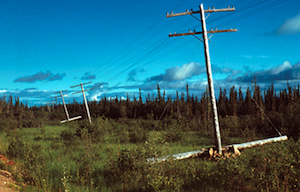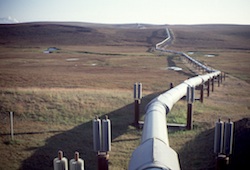|
Permafrost is a common
feature of the arctic tundra climate and biome. Permafrost refers to permanently frozen
ground. Actually, the ground has two layers which freeze. A surface layer, called the
active layer, thaws during the short "summer" and often subsides. Beneath the
active layer is the inactive layer which stays frozen throughout the year. Permafrost
creates a barrier to the rootdevelopment. Larger trees can grow along better drained
river valleys where the depth to permafrost is greater. The annual freezing and thawing
disrupts root systems inhibiting the growth of very tall vegetation. Figure 13.28 Trans-Alaska
pipeline snakes across the Alaskan tundra Permafrost creates an engineering nightmare for the construction of buildings and other structures. You can see in Figure 13.26 how telephone poles have been tilted from the heaving of the surface during freezing and thawing. Much concern for damage to the environment was raised over the construction of the Trans-Alaska Pipeline. The heated oil running though the pipeline is insulated from the cold permafrost where it runs underground. In places it zigzags over the surface on stilts that allow it to expand and contract.
|
 Figure 13.27
Figure 13.27